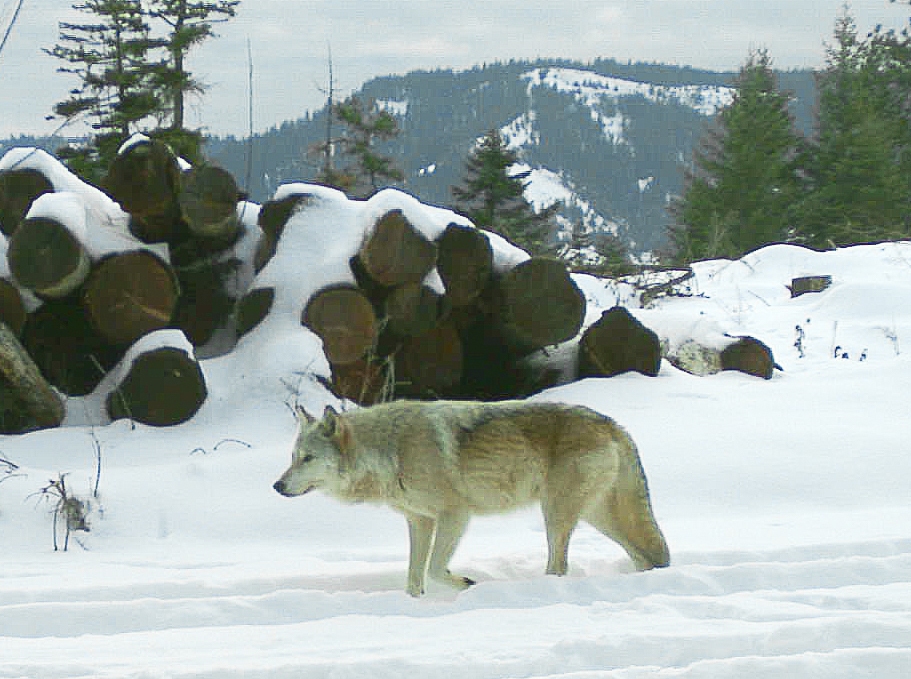Little Info Made Public On Deaths Of 5 Northeast Oregon Wolves
Oregon investigators remain tight lipped on the deaths of five wolves northeast of La Grande, first reported on Friday.
ODFW today referred inquiries to the state police, where spokesman Capt. Timothy Fox did not answer a series of questions and indicated he had no more information to share.

The basics that Fox has made public is that just after noon on February 9, ODFW reported a mortality signal on a collared wolf in Union County, in the vicinity of Mt. Harris and USFS Road 62.
“Upon arrival at the location a total of five wolves were found deceased. The cause of death is unknown. All five carcasses were taken to the U.S. Fish and Wildlife forensic lab to determine the cause of death,” an OSP statement reads.
As Saturday’s widely distributed Associated Press story noted, no further details were released.
The USFWS forensics lab is in Ashland, in Oregon’s southwest corner, and in response to questions from a reporter earlier today, its director, Ken Goddard, said their analytical results are only shared with the investigating body that submits evidence.
The lab was in the news recently for excellent work pinning the remains of six elk and deer killed inside Crater Lake National Park with parts recovered at the home of a local man.
Back in Northeast Oregon, the location where the five wolves were found puts the incident in the range of the Clark Creek Pack, which numbered six at the end of 2019. Oregon’s 2020 statewide wolf survey will be released in the coming weeks.
With so little information reported, it’s all speculation at this point about how the wolves died, but one possibility leaped to mind for one regional wolf expert I queried.
“My first thought would be some kind of poisoning activity – five dead wolves located using one radio-collared animal suggests the carcasses were in a fairly small area,” said retired US Fish and Wildlife Service wolf biologist Carter Niemeyer.
He is not part of the state investigative team, but described by The Oregonian several years ago as a “former wolf hit man” turned “unlikely advocate,” during Niemeyer’s time with the federal government in the Northern Rockies states, he assisted with the reintroduction of wolves in Central Idaho and Yellowstone in the mid-1990s, as well as their lethal removals, among other animal control work.
“Fast-acting poison could do that,” Niemeyer added, “or another possibility would be if someone killed them and hauled them to a single location to skin them or some other exhibit.”
As part of his job recovering wolves, he also investigated livestock losses, using forensic techniques to determine causes of death of sheep, calves and other farm animals, methods since shared widely with wildlife agencies and others.
While a Yellowstone study found wolves with mange to be vulnerable to very cold, windy weather, Niemeyer doubts natural causes in this case.
“I couldn’t fathom five adult wolves succumbing to a disease or parasite and dying so close together as to be found. Seems like the carcasses must have been in a fairly open situation visible from the air or, perhaps from bird concentrations. A mystery,” he said.
Wolves have been federally delisted throughout Oregon but remain under state protections.
Such as they are – recent months have seen lawmakers in Idaho and Montana proposing all sorts of heavy-handed wolf bills, with a lawsuit-forced Wisconsin hunt exceeding its quota by quite some margin.
“People are killing them because they can – pure retribution,” Niemeyer lamented.
OSP in consultation with the USFWS Forensics Lab will make the ultimate call on what killed the Northeast Oregon wolves, but there has been at least one other mass die-off of Canis lupus in the Northwest in recent years.
In August 2012, the US Fish and Wildlife Service offered a $2,500 reward for information on the deaths of four wolves and six eagles found inside the Bob Marshall Wilderness of Northwest Montana in May of that year. Lab work said they died of poisoning.
It’s unclear if that was ever solved; Google searches turn up only the initial press release and news articles but no case results.
For now, what happened in Northeast Oregon is, like Niemeyer says, “a mystery.”
